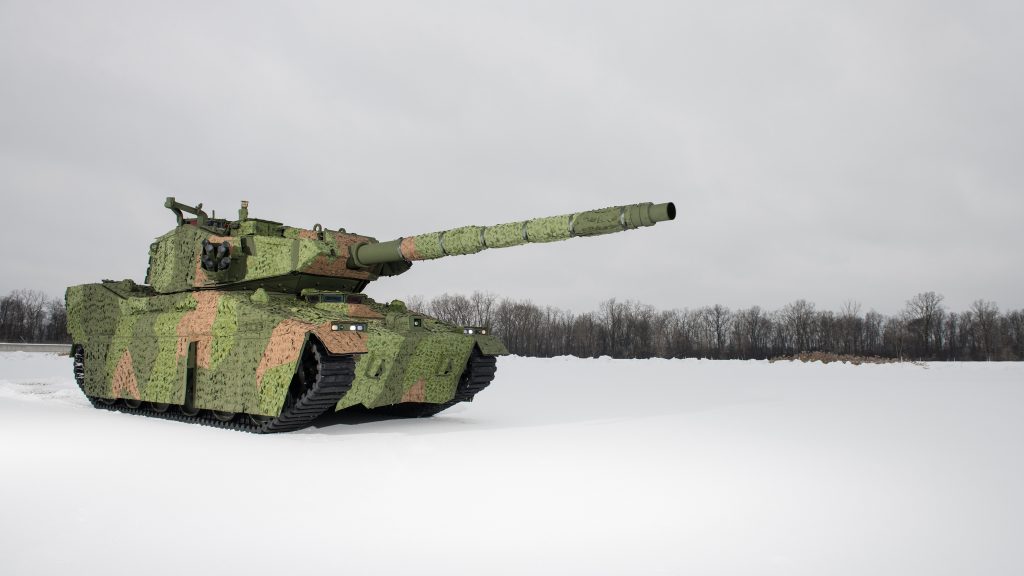
BAE Systems’s prototype for the Army’s Mobile Protected Firepower (MPF) light tank.
WASHINGTON: The pandemic has disrupted a second BAE Systems armored vehicle program, this time delaying deliveries of prototype Mobile Protected Firepower vehicles to the Army’s 18th Airborne Corps at Fort Bragg.
Earlier this year, problems with COVID and quality control at BAE’s York, Penn. factory delayed delivery of BAE’s Armored Multi-Purpose Vehicle – the replacement for the vulnerable, Vietnam-vintage M113 – by several months. Now I’ve learned that COVID has also affected production of the MPF, an air-deployable light-tank, whose prototypes are being built at a BAE facility in Sterling Heights, Mich.
One critical difference? While BAE has already won the contract to produce the AMPV, it’s still competing with archrival General Dynamics Land Systems for the right to build the MPF. The Army plans to build 504 of the light tanks to accompany airborne troops and other light infantry units, which lack the logistical apparatus to support the massive M1 Abrams and often deploy rapidly by aircraft.

General Dynamics prototype Mobile Protected Firepower (MPF) light tank
As part of the Army’s new drive to get hands-on feedback from regular soldiers before buying new equipment, both companies are providing MPF prototypes to troops at Bragg. From Jan. 4 though June, those soldiers will crawl all over the vehicles, learn to operate and maintain them, take them through field exercises, and start developing tactics for the tanks. While this Soldier Vehicle Assessment is not “a formal test event,” as Army officials take pains to emphasize, it’ll definitely play a role in the service’s decision, with a production contract award expected in the second half of 2022.
The Army announced on Friday that “the first of several” MPF prototypes had arrived at Bragg. Then General Dynamics said on Monday it had delivered 10 of the 12 prototypes it owed the Army, with the last two vehicles coming later this month. BAE, however, only made a statement that “we will deliver a test platform within the week, [in time] to support SVA and get this vehicle into soldier’s hands for evaluation.”
But “delivered” in defense contracting jargon simply means something has been formally handed over to the buyer’s possession, not that it’s been physically shipped to its destination. (For example, Israeli firm Rafael ceremoniously “delivered” its first Iron Dome missile defense battery to the US Army back in September – when the weapons were still physically at its factory in Israel).
So I did a little digging. Pulling together several sources, it became clear that at least two General Dynamics vehicles are now actually at Bragg: One arrived Dec. 10th, the second Dec. 11th. (It’s possible more have arrived by now; we’re checking). But the BAE vehicles weren’t there yet. In fact, as the statement “we will deliver a test platform” implied (emphasis mine), they weren’t even officially handed over to the Army. The reason, I was told, is COVID.
Now, this isn’t a significant setback for the Army program. It’s not even a big problem for BAE’s bid. The military builds plenty of margin into its timelines to try out new equipment – indeed, the Army acquisition system in particularly is notoriously over-cautious and slow. So as long as BAE gets enough vehicles to Fort Bragg for the soldiers to get started on Jan. 4th, the evaluation can proceed as planned. But the delay is one more sign of how the pandemic is disrupting everything.
Baes_infographic Dist A_Army Approved Version by BreakingDefense on Scribd
Jordan’s Abdullah II defends shootdown of Iranian munitions over its airspace during attack on Israel
Amid Iranian criticisim, “Jordanian leaders have been very clear to portray their action as defensive and in protection of their own sovereignty rather than any act in support of Israel, and this is sincere,” an analyst told Breaking Defense.


























